Abstract
This paper is a publication of P. Turin CGT 54019, which contains an excerpt from The Teaching of Khety, also known as The Satire of the Trades. The papyrus provides a welcome additional source for the second part of the composition (chapters 21–30), particularly because it offers some interesting variants that are unparalleled in the other sources. After a brief introduction on variants in general, including scribal errors, these variants are discussed in detail. The colophon that concludes the papyrus is badly preserved. However, it mentions the mortuary temple of Ramesses III at Medinet Habu. This is quite remarkable, since locations are seldom referred to in the colophons of literary texts. These rare instances are analyzed here to try to reconstruct the manuscript’s colophon. Finally, the relationship between literary texts and mortuary temples is discussed to shed light on the social context of P. Turin CGT 54019.
1 The “discovery” of the papyrus
On 8 September 1978 Alessandro Roccati identified amongst the unpublished papyri in the Museo Egizio in Turin a papyrus fragment containing an excerpt from The Teaching of Khety, also known as The Satire of the Trades.1 Some years later (14 September 1983) he identified yet another fragment with a passage from Khety close to the one on the previously discovered fragment. As Roccati realised, it was an important find, for together the two fragments constituted the second half of Khety (chapters 21–30), thus providing a welcome additional source for this portion of the text, which was less frequently copied by the ancient Egyptian scribes than the more attractive first part that describes the various laborious professions. Moreover, the manuscript provided a good, although not faultless, version of the composition, which is infamous for its unintelligibility due to the many mistakes and variants occurring in the source material. Roccati made use of the papyrus for his translation of Khety that appeared in 1994 as part of an anthology of ancient Egyptian texts.2 This, however, remained largely unnoticed by the scientific community. Roccati again pointed out the existence of the papyrus in an article published in 2000 in which he also provided a transcription of four
The numbers Roccati assigned to the papyrus have been the cause of some confusion. On several occasions, Roccati refers to the papyrus in its entirety (i.e. the two fragments together) as P. Turin CGT 54017, and hence so does Jäger, following Roccati. In one of his articles Roccati lists, among various (unpublished) papyri in the Turin museum, a “P. Turin CGT 54017: Satira dei Mestieri (=pSallier II 9,5–11,5). Identificato l’8.9.1978”. Beneath this entry, however, he lists another papyrus “P. Turin CGT 54018: come il precedente. Identificato il 14.9.1983”.5 The latter can only refer to one of the two fragments identified by him, since no other substantial manuscript containing Khety has so far been discovered amongst the papyri in Turin.6 However, Roccati’s numbers are incorrect, for neither CGT 54017 nor CGT 54018 contain excerpts from Khety.7 P. Turin CGT 54019 (TPOP Doc ID 543), on the other hand, fits Roccati’s description of the papyrus nicely, and the evidence suggest this must be the manuscript he discovered in the Turin collection. Part of the confusion seems to have arisen from the fact that the papyrus consists of two fragments mounted in two separate frames (Fig. 1 and Fig. 2), both of which were identified by Roccati some years apart. In this paper I will not only provide the first hieroglyphic transcription of CGT 54019 to appear in print, and discuss variants of the text, but also contextualise the papyrus based on its colophon.
CGT 54019, recto, mounted in frame 1 (columns 2 and 3). Scan by the Museo Egizio.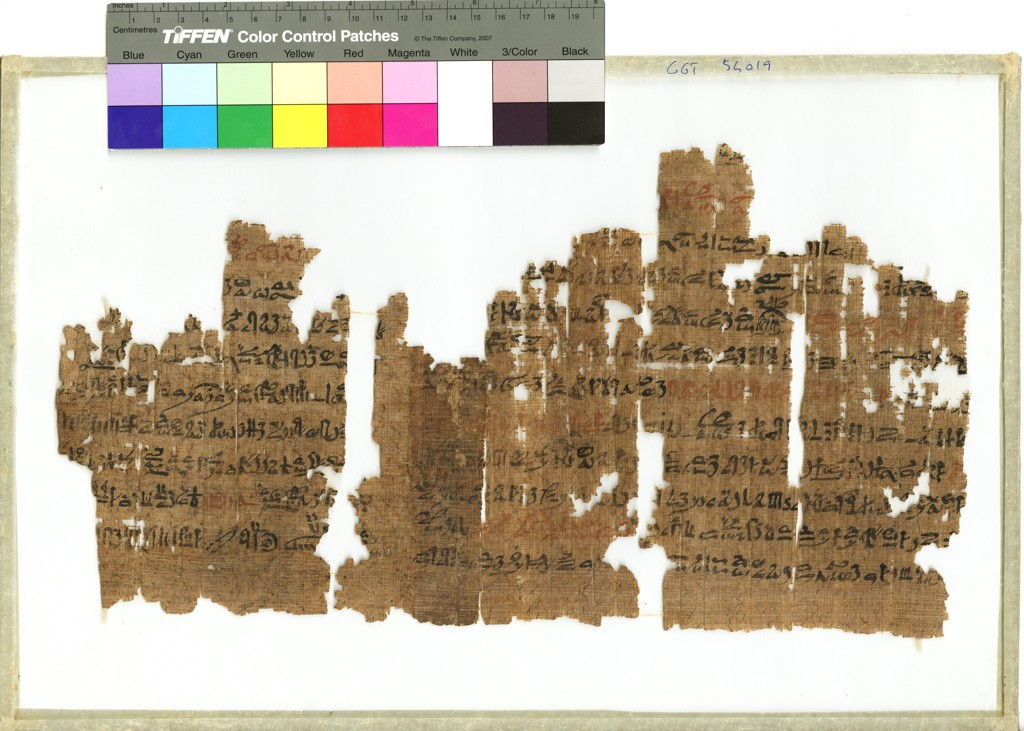
CGT 54019, recto, mounted in frame 2 (column 1). Scan by the Museo Egizio.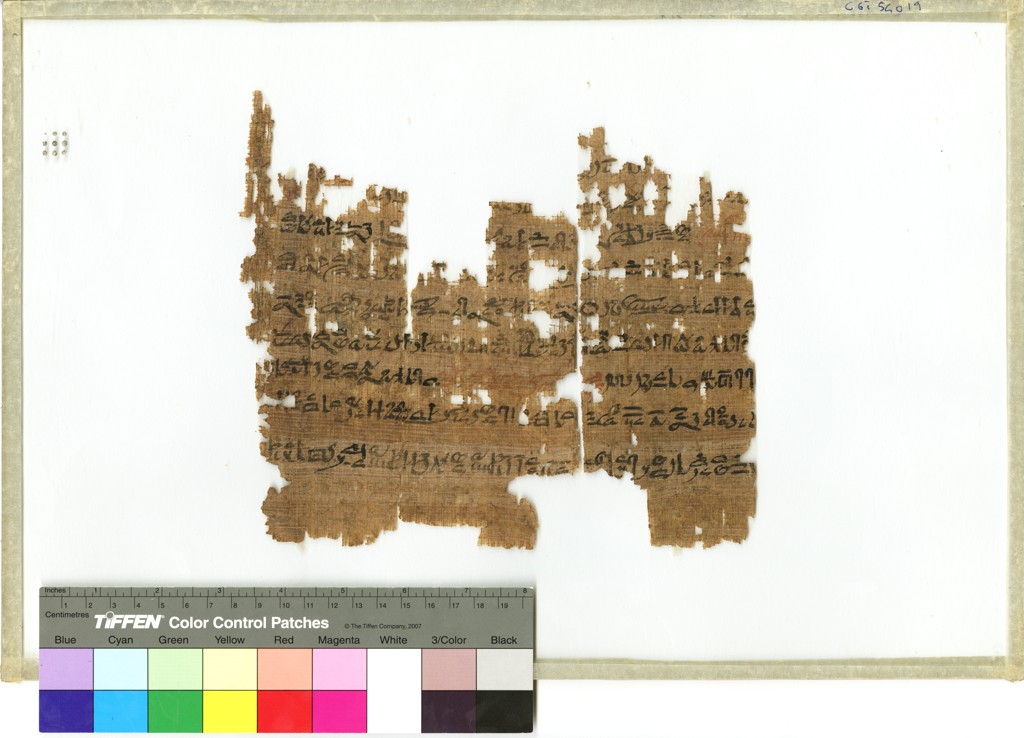
2 Description of the papyrus
P. Turin CGT 54019 survives in two fragments that are mounted in two separate frames. The largest of the two fragments (Frame 1) measures 38 x 20 cm (Fig. 1). The smaller one (Frame 2) measures 21 x 18.5 cm (Fig. 2). The numbering of the frames is misleading, for the fragment in frame 2 actually precedes the fragment in frame 1. Hardly anything is missing between the two pieces, so that they can almost be joined directly, having become separated only by a vertical crack (for a virtual reconstruction, see Fig. 3). Similar cracks appear throughout the manuscript at regular intervals (approximately 7 cm apart), suggesting that the papyrus was rolled-up and subsequently pressed down. The papyrus has suffered further damage, resulting in a number of lacunae. The verso is blank, apart from some traces of red ink, which may be pen trials or the remnants of a doodle (Fig. 4). The recto contains three columns of hieratic text written in horizontal lines. The first column is missing approximately 2.5 cm at the beginning; the second column is preserved to its full width (23 cm); the third column has lost about 10 cm at the end, assuming it had the same width as the other two. It seems likely that the manuscript once contained the entire composition, and thus that several sheets preceded the column now numbered 1. The third column contains the end of Khety followed by a colophon. It is likely that this also constituted the end of the papyrus, as the handwriting in the third column appears denser, as if the scribe was doing his best to finish the text within the available space. While the length of the papyrus
Virtual reconstruction of CGT 54019 by the author, based on scans by Museo Egizio.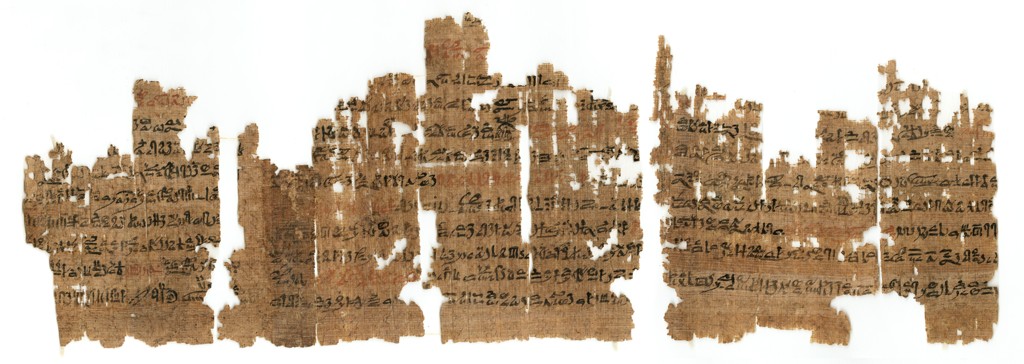
CGT 54019, detail of the verso. Scan by the Museo Egizio (with colour enhancement by the author).
3 Provenance and date
Nothing is known about the origin of the manuscript. There is no information about the papyrus provided in the museum records other than its current number. Most of the Ramesside papyri in the Museo Egizio stem from western Thebes and came into the possession of the museum when Bernardino Drovetti (1776–1852) sold his first collection to the king of Sardinia in 1824. Drovetti was not only the French consul in Egypt at the time, but also a collector of Egyptian antiquities, whose agents were particularly active on the Theban west bank, most likely including the workmen’s village of Deir el-Medina.10 Other papyri now housed in Turin were excavated by Ernesto Schiaparelli (1856–1928) in Deir el-Medina. It is not known whether CGT 54019 originates from Drovetti’s collection or from Schiaparelli’s finds. However, since most of the papyri in the Turin collection seem to originate from the village of Deir el-Medina, western Thebes as a provenance is highly likely, also considering the colophon that refers to the mortuary temple of Ramesses III at Medinet Habu (see below). It is interesting the papyrus stems from this area, since both P. Sallier II and P. Anastasi VII (the only manuscripts containing more chapters of Khety than CGT 54019) are likely to have a Memphite origin.11 The manuscript dates from the Ramesside Period, more precisely the Twentieth Dynasty. The fact that Ramesses III is mentioned provides us with a terminus post quem.
4 Palaeography
The palaeography of the manuscript confirms its dating to the Ramesside Period (see Table 1). The scribe’s handwriting is neat, free of ligatures, round, and of average size. He had a tendency to add dots to certain signs, e.g.  (
( (1,2; 2,10; 3,7; see also below), an example of Late Egyptian orthography. The manuscript lacks verse points.13 This is a noteworthy feature, since the use of these “verse points” was widespread in the New Kingdom, especially in literary texts.14
(1,2; 2,10; 3,7; see also below), an example of Late Egyptian orthography. The manuscript lacks verse points.13 This is a noteworthy feature, since the use of these “verse points” was widespread in the New Kingdom, especially in literary texts.14
Overview of the signs showing features common in the Ramesside period.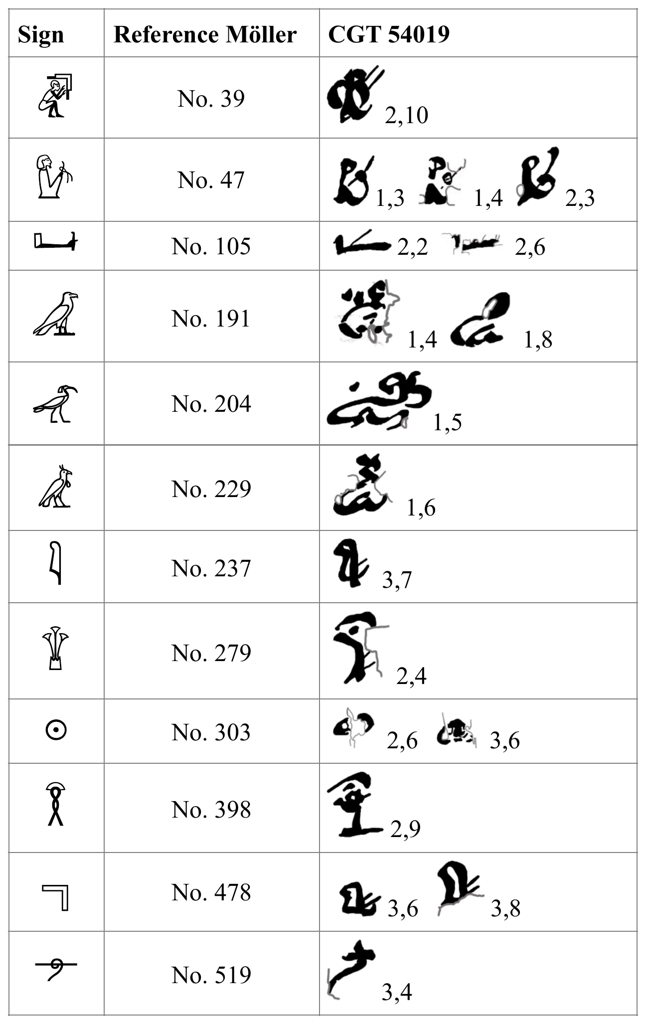
Idiosyncratic signs of the scribe of CGT 54019, including his distinctive writing of the pronoun 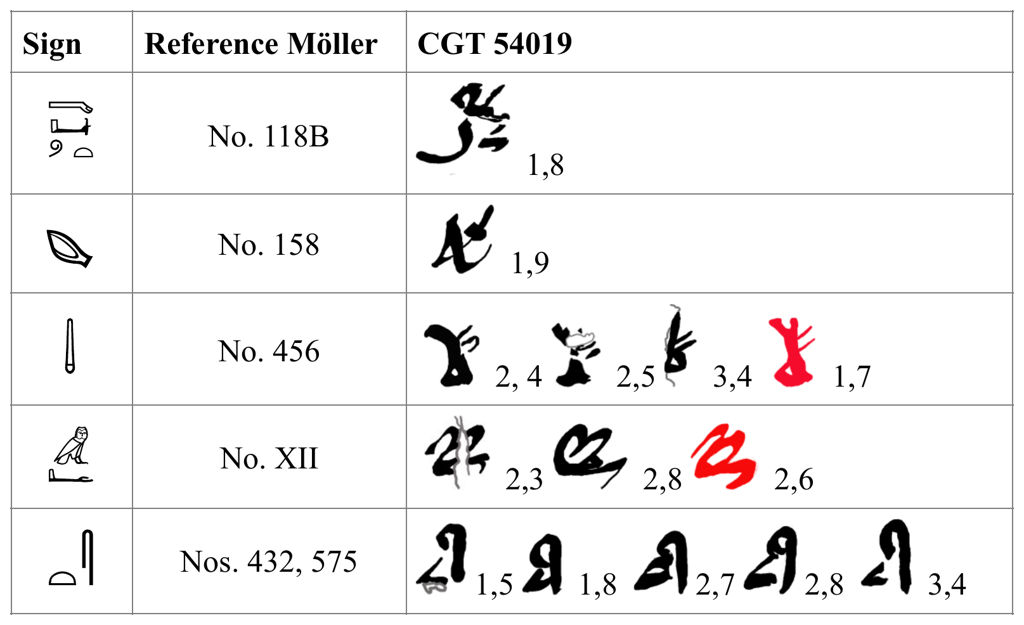
5 Hieroglyphic transcription and commentary
The Teaching of Khety is known for its many mistakes and variants, making it a notoriously difficult text, to such a degree that John Foster remarked: “The so-called Satire on the Trades, containing Khety’s instruction to his son Pepi, is one of the most confusing, garbled, and unintelligible literary texts to survive from ancient Egypt.”15 CGT 54019 contains some variants that are unparalleled in the other source material of Khety.16 Many of these help to
In the past, variants that occurred in manuscripts were often seen as mistakes, a corruption of the perfect text originally composed by the author. Philologists tried to identify these “errors” in order to reconstruct a hypothetical Urtext. The most recent edition of Khety by Stephan Jäger is a good example of this traditional approach. Jäger makes use of stemmata to establish a hierarchy of manuscripts and uses the results to reconstruct an Urtext.17 Cerquiglini, however, has convincingly argued that it is impossible and indeed irrelevant to retrieve an original text from supposedly faulty copies, for “medieval writing does not produce variants; it is variance,” and “every copy is alteration”, meaning that variants and mistakes are an inherent feature of textual transmission.18 Recently this approach, known as “New Philology” or “Material Philology”, has also found footing within Egyptology.19
Variants thus have a value of their own; they may offer insights into the social conditions of textual production. As early as the 1970s, Burkard analysed mistakes and variants in ancient Egyptian wisdom texts, including The Teaching of Khety. Regarding the latter, he concluded that the sources contained many reading errors (“Lesefehler”), a few memory mistakes (“Gedächtnisfehler”) and no hearing errors (“Hörfehler”). Thus, according to his analysis, the preferred method of textual transmission was copying the text from another manuscript as opposed to writing from memory (which did occasionally occur) and copying from dictation.20
True to the old philological tradition, Burkard saw many variants as mistakes, but in reality it is often difficult to identify the purpose behind a particular variant: whether it is a real error, made unconsciously by the scribe, resulting in a faulty (sometimes incomprehensible) version of the text; a “conscious” modification, for example when a scribe did not remember a particular detail and replaced it with something else;21 or a redactional variant, the scribe knowingly adapting the text, for example to facilitate the understanding of a sentence or to update the text, for instance by using Late Ramesside orthography. A further difficulty lies in discerning if the mistake or variant was made by the copyist himself or if it was already part of a corrupt textual tradition, the scribe faithfully copying the text as he knew it.22 Either way, the study of variants can reveal much about the engagement (or non-engagement) of the scribe with the text he copied.
In the following section I will comment on the variants of CGT 54019 that are unparalleled in other sources. It falls outside the scope of this paper to give a detailed analysis of every variant of the manuscript (a full new edition of The Teaching of Khety is in preparation by the present author), but the discussion below will touch upon the matters discussed above.
5.1 Column 1: chapters 21,4–23,4
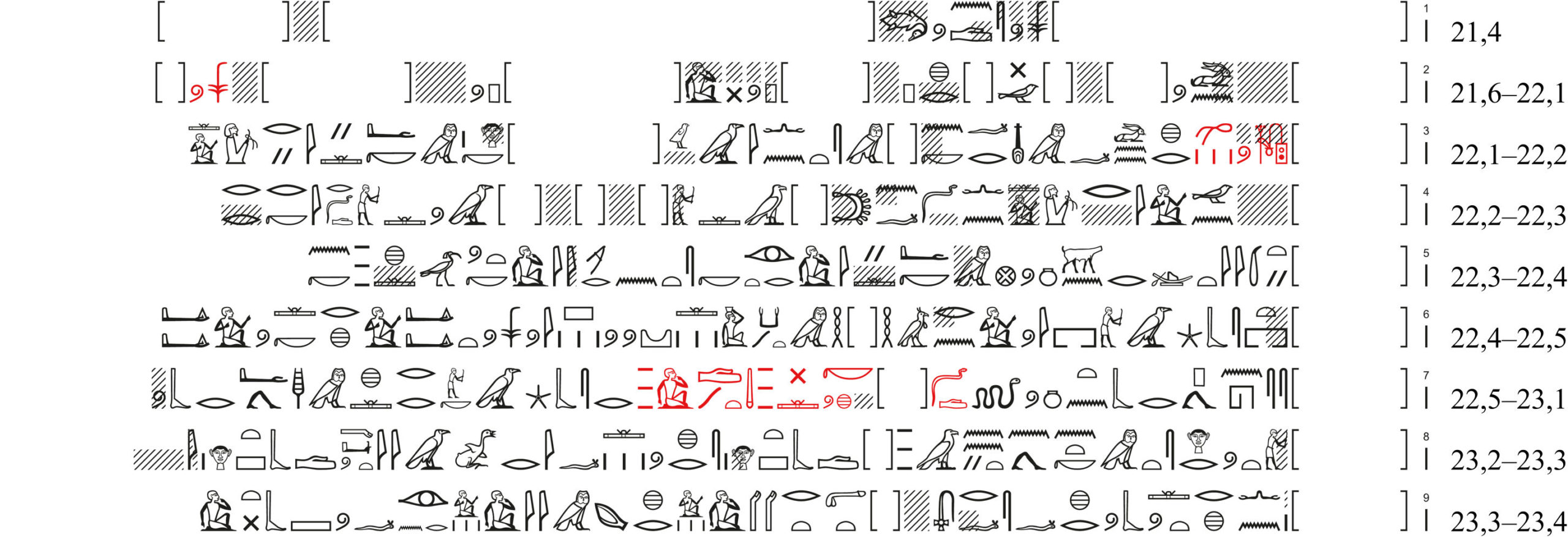
[…]
[…]
21,4
[
Fear [has blinded] him.
21,5
[…]
[…]
[…]
[…]
21,6
[
[Look,] there is [no profession free of] supervisors,
[
except for [that of scribe: he is the] supervisor.
22,1
[
But [if you know] writing,
then it will go well with you because of it.
There are no professions […] your face.
22,2
Look, the subordinate! [Miserable is] the subordinate to me.
A field worker will not say to him […] (?)
[
[Beware] of speech about you.
22,3
{
[…] travelling southwards to the Residence,
look, you have done it for love of yourself.
22,4
[A day in school] is beneficial for you,
while I will be forever in mountain labour.
22,5
But while I will make you knowledgeable,
[…] will cause …?… against …?…
23,1
[I] will say other words [to you],
to teach you knowledge.
23,2
Do not stand at a place where there is [fighting].
<Do> not <be close> to those on whose plans is a brick.
23,3
If a brick is taken [by a hasty-hearted person],
one will not know the place where he is, being hot […] (?)
23,4
Testify before the judges,
answer him […]
21,6 (column 1, line 2): [
22,1 (column 1, line 3):
22,2 (column 1, line 4): [
22,3 (column 1, lines 4–5): { . Because of the lacuna that follows, it is difficult to say whether this really constitutes a new variant or is simply a miswriting for
. Because of the lacuna that follows, it is difficult to say whether this really constitutes a new variant or is simply a miswriting for  as written in the other sources, although in the latter cases it is mostly preceded by
as written in the other sources, although in the latter cases it is mostly preceded by
22,3 (column 1, line 5):
22,4 (column 1, line 6):
22,5 (column 1, line 6):
22,5 (column 1, lines 6–7):
23,1 (column 1, line 7):
23,2 (column 1, lines 7–8):
23,2 (column 1, line 8):  ) is a Late Egyptian expression (Wb II.195.5) and is here a corruption for
) is a Late Egyptian expression (Wb II.195.5) and is here a corruption for
23,3 (column 1, lines 8–9):
23,3 (column 1, line 9):
5.2 Column 2: chapters 24,1–28,3
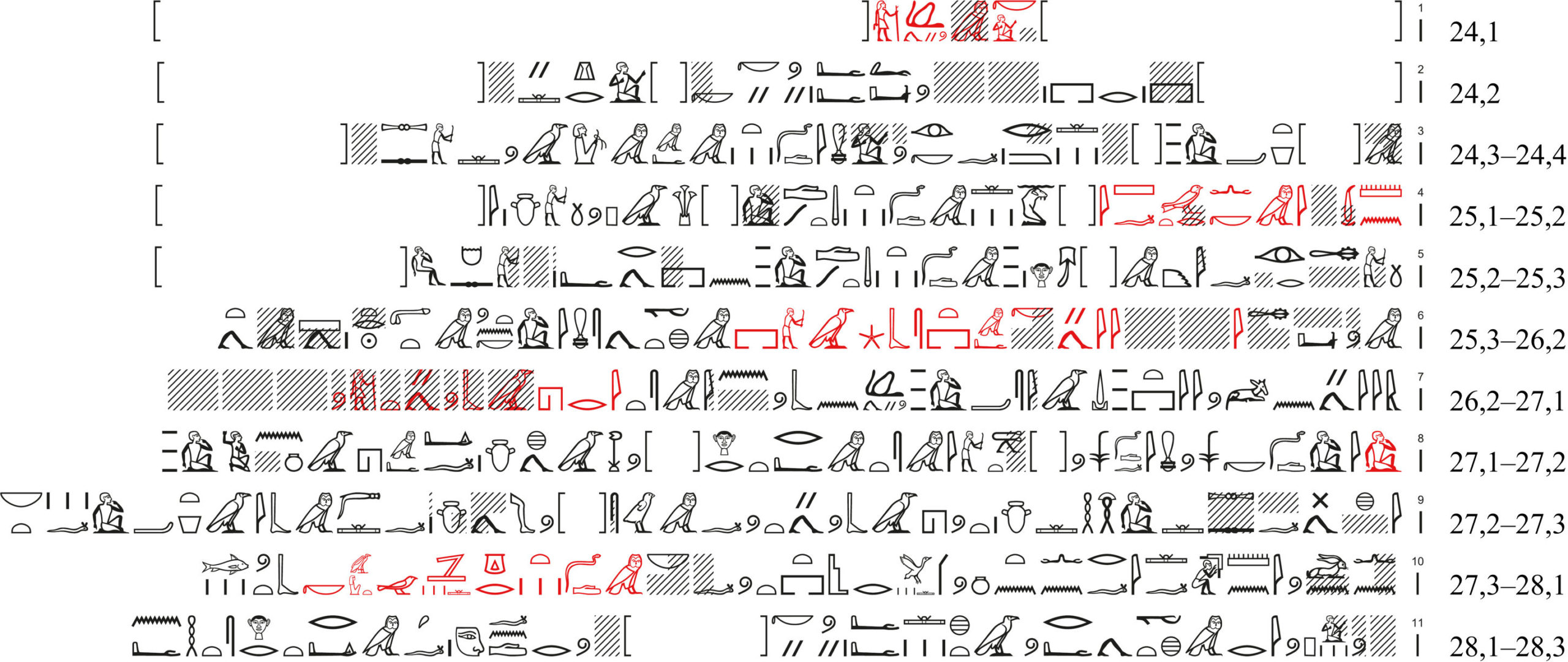
24,1
[
[If] you [walk] behind noblemen,
[…]
[…]
24,2
[
[If you arrive while the master of] the house is in the house,
[…]
[…] your arms, while someone else is under […]
24,3
[…]
[…]
[Do] not [ask for the things] at his side.
24,4
May you do according to what was said among them.
{
Beware of […]
25,1
[
[Be weighty] in yourself, great of respect.
25,2
Do not tell secrets [of] the heart.
[One who hides] his inner thoughts [has] made a shield concerning them.
25,3
Do not speak reckless words,
sitting […] someone who is defiant.
26,1
If you leave the school,
after midday is announced to you,
26,2
(after) coming and going in the streets,
advise the end of the place where [you] are. (?)
27,1
When a magistrate sends you [with a message],
you shall say it as he said it.
[
Do [not] take away from it; do not add to [it].
27,2
[
A quick-thinking-one causes jubilation.
[…] [causes] kind speech
{
He is sent unhindered.
27,3
He trusts in all his good character traits.
There are no secrets for him.
There is no one promoted in any position that is his.
28,1
Do not tell lies against your mother:
it is the horror [of noblemen].
28,2
After things have been given,
your arms […] his nose.
28,3
Do not add to it with […]
[…]
[…]
24,2 (column 2, line 2): [
24,2 (column 2, line 2): […]  an
an
24,4 (column 2, line 3):  ) is more correct than its counterpart in P. Sallier II and P. Anastasi VII (
) is more correct than its counterpart in P. Sallier II and P. Anastasi VII (  ).
).
25,2 (column 2, line 4):
25,2 (column 2, lines 4–5):
25,3 (column 2, line 5–6):
26,2 (column 2, lines 6–7):
26,2 (column 2, line 7):
27,1 (column 2, line 8):
27,1 (column 2, line 8): [
27,2 (column 2, line 8): [ is not paralleled in the other sources, which have
is not paralleled in the other sources, which have ), or
), or  )
)
27,2 (column 2, line 9):
27,2 (column 2, line 9): {
27,3 (column 2, line 9):  in line 3. It most likely concerns the same variant, so that after
in line 3. It most likely concerns the same variant, so that after
27,3 (column 2, line 10):
5.3 Column 3: chapters 29,1–colophon
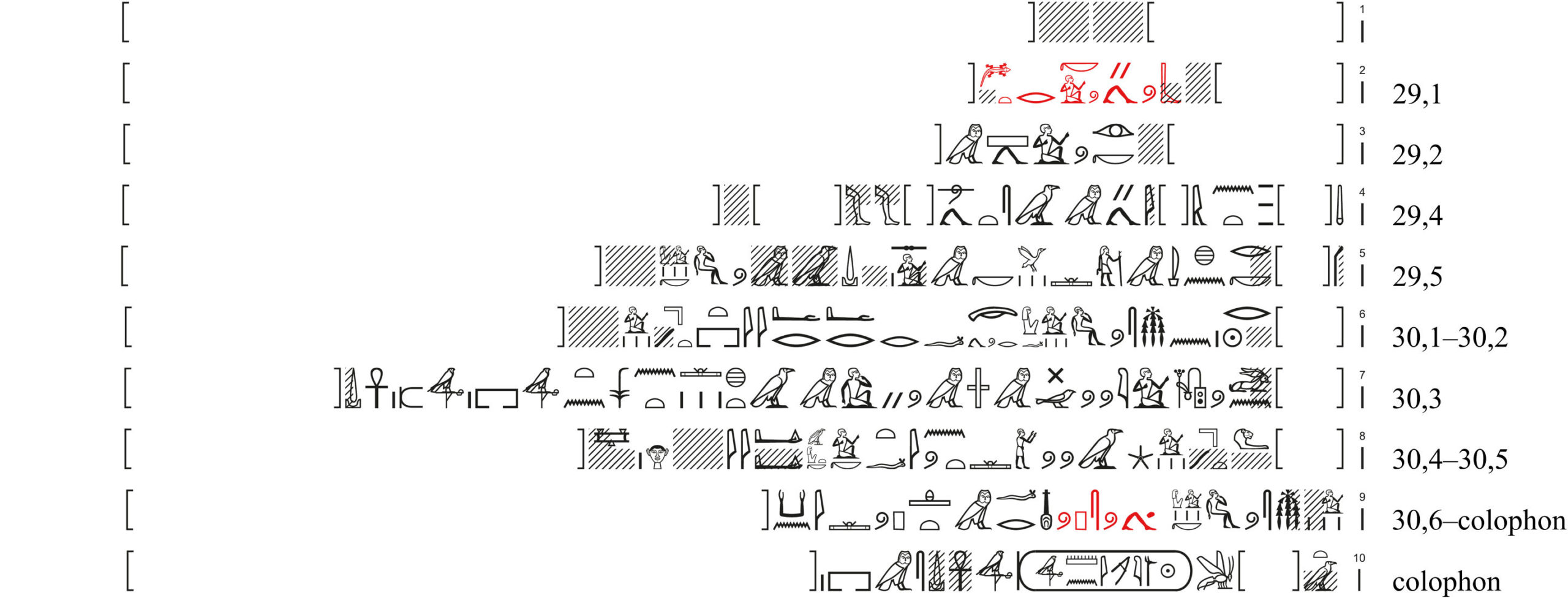
29,1
[
[See, it is good that] you send (messages) often.
[…]
[…]
29,2
[…]
[…]
while you go […]
29,3
[…]
[…]
[…]
[…]
29,4
[…]
[…] words of welcome.
Do not let [your] feet rush […]
[…]
[…]
29,5
[
[Associate with someone who is more distinguished] than you.
May you befriend a man of your generation.
[…]
[…]
30,1
[
on the day of his birth.
30,2
He reaches the office,
the council […]
30,3
[
[Look,] there is [no] scribe devoid of eating
from the food of the palace l.p.[h.]
30,4
[…]
[…]
[…] [
[…] before the council.
30,5
{
< Praise god for> your father and your mother,
who are placed on the road […]
30,6
[…]
[…]
[
the children of your children.
29,1 (column 3, line 2):
29,4 (column 3, line 4):
29,5 (column 3, line 5): [
30,2 (column 3, line 6):
30,3 (column 3, line 7):
30,5 (column 3, line 8): { are a mistake for
are a mistake for
30,6 (column 3, line 9): [
6 The colophon
P. Turin CGT 54019 ends with a colophon, written after the closing words of Khety (column 3, lines 9–10):
-
iw=s pw nfr m Htp in >kA n […]tA [Hw.t nsw ]bity wsr-mAa.t-ra mry-imn a-w-s m pr [imn ]It is come ,67 well and in peace. For the ka of […]the [Temple of the King of Upper and] Lower Egypt, Usermaatra Meryamun, l.p.h. in the domain of [Amun]
The phrasing of the colophon is typical for the New Kingdom.68 The expression
The occurrence of a location (the temple of Medinet Habu) in the colophon is noticeable, since this is very uncommon. In fact, locations are so rarely mentioned that this aspect of the colophon has not been discussed before in the Egyptological literature on colophons. In this section I will discuss the relevant examples in order to try to reconstruct the context in which the temple is mentioned in the colophon of CGT 54019.
Locations in colophons occur in three different types:
- as the location where the king happened to be at the time of writing
- as the location where the document was written
- as part of the title of the scribe
Type 1 has only one example. The colophon in question concludes The Teaching of Khety on P. Anastasi VII. It reads as follows:
-
iw=s pw nfr m Htp• in kA n sS [pr-HD ]qA [gAbw ]• [sS ]pA-Hrj-pD.t • sS iwti • sS mry-ra • ir.n sS in-nA pA nb n tA sbAy.t • m rnp.t-zp 6Abd 2Smw sw 15• iw=tw m pr-ra-msj-sw mry-imn-a-w-s-pA-kA- [aA ]-n-pA-ra-Hrw-Axtj • It is come, well and in peace. For the ka of the scribe [of the Treasury] Qa[gebu and the scribe] Paheripedjet and the scribe Iuti and the scribe Meryre. Made by the scribe Inena, the owner of the teaching, in year 6, second month of Summer, day 15, while One (i.e. the King) was in House-of-Ramesses-Beloved-of-Amun-l.p.h.,-the[-Great]-Spirit-of-Pre-Harakhti.71
After the standard formulae of the colophon follows a date and the remark that the King was in Piramesse, the Ramesside capital in the Delta. Apparently, the scribe considered the event important enough to add to the colophon. It probably helped him remember the occasion when the papyrus was written. The phrase “while the King was in (
Type 2 is also represented by a single example, namely the colophon at the end of the The Contendings of Horus and Seth. It reads:
Type 3 occurs much more frequently. The relevant examples mostly name scribes (
-
iw=s n tA Hw.t nsw bity HqA-mAat-ra stp.n […]It is […]of the Temple of the King of Upper and Lower Egypt, Heqa-Maat-Ra Beloved-of-[…]
Although the colophon is fragmentary, it seems clear that the
The association with temples is also apparent in another colophon that cannot be added to one of the three categories due to its fragmentary state. It concerns the colophon of the Blinding of Truth by Falsehood.78 At some point it states
Taking all of the above into account CGT 54019 may be added to the third category, i.e. the mortuary temple occurs here as part of a title, either of the scribe who copied the text or the person to whom the text was dedicated. This assumption is not only based on statistical grounds, but also on the close parallel with the Turin papyrus containing the Hymn to Hapi. Furthermore, the title “scribe of + mortuary temple” occurs more often. Another example of someone holding this title is Pentaweret who is called a
7 Social context
From circumstantial evidence, including titles of scribes like the ones mentioned above, we know that scriptoria (i.e. places connected to scribal activities) such as the House of Life or the House of Books were associated with temples.80 Nevertheless it has been proven difficult to archaeologically identify the structures where these scribal activities took place within the precincts of the temples. Literary material was found at the site of various mortuary temples on the West Bank. In the mud-brick buildings surrounding the Ramesseum fragments of literary papyri were discovered, which point to the existence of an archive or library there.81 Furthermore, excavations in the southwestern area of the temple have yielded the remnants of 17 small chambers with a forecourt attached. Many ostraca were found there, including literary ones. The excavators identified this structure as a school (
All in all, the presence of literary material at these sites shows that literary activities were being conducted within the enclosures of mortuary temples, which probably also served as places of training for young scribes. The colophon of CGT 54019 indicates that the papyrus was written by or for a scribe connected to the mortuary temple of Ramesses III. It is likely that the temple was also the place where the text was produced. Thus within the precincts of the temple of Medinet Habu there also existed a place where (literary) texts were copied, as in the other mortuary temples discussed above.
Bibliography
Abrahami, P. and L. Coulon, “De l’usage et de l’archivage des tablettes cunéiformes d’Amarna”, in: L. Pantalacci (ed.), La Lettre d’archive. Communication administrative et personnelle dans l’Antiquité proche-orientale et égyptienne. Actes du colloque de l’université de Lyon II, 9-10 juillet 2004 (BiGen 32), Cairo 2008, pp. 1–26.
Allen, J., Middle Egyptian: An Introduction to the Language and Culture of Hieroglyphs, Cambridge 2000.
Barbotin, C., “Les ostraca hiératiques de l’école du Ramesseum”, Memnonia 24 (2013), pp. 73–79.
Bierbrier, M., Who Was Who in Egyptology, London 20195.
Broze, M., Mythe et roman en Égypte ancienne : les aventures d’Horus et Seth dans le papyrus Chester Beatty I (OLA 76), Leuven 1996.
Brunner, H., Die Lehre des Cheti, Sohnes des Duauf (ÄgForsch 13), Glückstadt 1944.
Burkard, G., Textkritische Untersuchungen zu ägyptischen Weisheitslehren des Alten und Mittleren Reiches (ÄA 34), Wiesbaden 1977.
Caminos, R., Late-Egyptian Miscellanies (BEStud 1), London 1954.
Černý, J., Paper and Books in Ancient Egypt: An Inaugural Lecture Delivered at University College London, 29 May 1947, London 1952.
Černý, J. and A. Gardiner, Hieratic Ostraca, I, Oxford 1957.
Černý, J. and S. Israelit Groll, A Late Egyptian Grammar, Roma 19934.
Cerquiglini, B., In Praise of the Variant: A Critical History of Philology, Baltimore 1999.
Daressy, G., Ostraca (CGC nos 25001–25385), Le Caire 1901.
Delnero, P., “Memorization and the Transmission of Sumerian Literary Compositions”, JNES 71/2 (2012), pp. 189–208.
Demarée, R., Ramesside ostraca, London 2002.
Demichelis, S., “Deux ostraca hiératiques découverts au Nord-Ouest du complexe de la ‘Chapelle de la reine blanche’”, Memnonia 14 (2003), pp. 87–91.
Erman, A., Neuaegyptische Grammatik, Leipzig 19332.
Fischer-Elfert, H.-W., Die Lehre eines Mannes für seinen Sohn: eine Etappe auf dem “Gottesweg” des loyalen und solidarischen Beamten des Mittleren Reiches (ÄA 60), Wiesbaden 1999.
Fischer-Elfert, H.-W., “Ostrakon hier. Straßburg H. 108: Brouillon eines Stiftungsvermerks oder Teil eines literarischen Kolophons des Schreibers Pasched”, GM 176 (2000), pp. 111–12.
Fischer-Elfert, H-W., “Review of Jäger, S., Altägyptische Berufstypologien (LingAeg Studia Monographica 4), Göttingen 2004”, LingAeg 15 (2007), pp. 307–14.
Foster, J., “Some Comments on the Instruction for Little Pepi on His Way to School (The Satire on the Trades)”, in: J. Larson and E. Teeter (eds.), Gold of Praise: Studies on Ancient Egypt in Honor of Edward F. Wente, Chicago 1999, pp. 121–29.
Foster, J., Ancient Egyptian Literature: An Anthology, Austin 2001.
Frère, M., “La nomination du vizir Ouseramon d’après le papyrus Turin Cat. 1878 vo”, RiME 3 (2019). La nomination du vizir Ouseramon d’après le papyrus Turin Cat. 1878 vo – Rivista del Museo Egizio.
Gardiner, A., “The Delta Residence of the Ramessides”, JEA 5/3 (1918), pp. 179–200.
Gardiner, A., Late-Egyptian Stories (BiAeg 1), Brussels 1932.
Gardiner, A., Hieratic Papyri in the British Museum: Third Series: Chester Beatty Gift, London 1935.
Gardiner, A., Late-Egyptian Miscellanies (BiAeg 7), Brussels 1937.
Gardiner, A., Egyptian Grammar: Being an Introduction to the Study of Hieroglyphs, Oxford 19573.
Goedicke, H. and E. Wente, Ostraka Michaelides, Wiesbaden 1962.
Goelet, O., “Writing Ramesside Hieratic: What the Late Egyptian Miscellanies Tell Us About Scribal Education”, in: S. D’Auria (ed.), Servant of Mut: Studies in Honor of Richard A. Fazzini, Leiden 2008, pp. 102–10.
Hagen, F., “Literature, Transmission, and the Late Egyptian Miscellanies”, in: R.J. Dann (ed.), Current Research in Egyptology 2004: Proceedings of the Fifth Annual Symposium Which Took Place at the University of Durham January 2004, Oxford 2006, pp. 84–99.
Hagen, F., An Ancient Egyptian Literary Text in Context: The Instruction of Ptahhotep (OLA 218), Leuven 2012.
Hagen, F., “On Some Movements of the Royal Court in New Kingdom Egypt”, in: J. van Dijk (ed.), Another Mouthful of Dust: Egyptological Studies in Honour of Geoffrey Thorndike Martin (OLA 246), Leuven 2016, pp. 155–81.
Hagen, F., “Libraries in Ancient Egypt, c.1600–800 BCE”, in: K. Ryholt and G. Barjamovic (eds.), Libraries Before Alexandria: Ancient Near Eastern Traditions, Oxford 2019, pp. 244–318.
Hagen, F., Ostraca from the Temple of Millions of Years of Thutmose III (Culture and History of the Ancient Near East 120), Leiden 2021.
Haring, B., Divine Households: Administrative and Economic Aspects of the New Kingdom Royal Memorial Temples in Western Thebes (EgUit 12), Leiden 1997.
Haring, B., “Saqqara: A Place of Truth?”, in: V. Verschoor, A. Stuart and C. Demarée (eds.), Imaging and Imagining the Memphite Necropolis: Liber Amicorum René van Walsem (EgUit 30), Leiden 2017, pp. 147–53.
Hawkings, E. (ed.), Select Papyri in the Hieratic Character from the Collections of the British Museum, London 1841–1860.
Helck, W., Die Lehre des
Hoch, J., “The Teaching of Dua-Kheti: A New Look at the Satire of the Trades”, JSSEA 21/22 (1991–1992), pp. 88–100.
Jäger, S., Altägyptische Berufstypologien (LingAeg Studia Monographica 4), Göttingen 2004.
Janssen, J., “On Style in Egyptian Handwriting”, JEA 73 (1987), pp. 161–67.
Jurjens, J., “The Educational Context of a Literary Text: Some Notes on Writing Exercises and Drawings as Found on Material Containing The Teaching of Khety”, JARCE 57 (forthcoming).
Jurjens. J., “Corrections on Ostraca: A Look into an Ancient Egyptian Scribal Practice”, SAK 50 (forthcoming).
Leblanc, C., “L’école du temple (ât-Sebaït) et le per-ankh (maison de vie) : à propos de récentes découvertes effectuées dans le contexte du Ramesseum”, Memnonia 15 (2004), pp. 93–101.
Lenzo Marchese, G., “Les colophons dans la littérature égyptienne”, BIFAO 104/1 (2004), pp. 359–76.
López, J., Ostraca ieratici (CMT. Serie Seconda – Collezioni 3), Milano 1978–1984.
Luiselli, M., “The Colophons as an Indication of the Attitudes towards the Literary Tradition in Egypt and Mesopotamia”, in: S. Bickel and A. Loprieno (eds.), Basel Egyptology Prize 1: Junior Research in Egyptian History, Archaeology, and Philology, Basel 2003, pp. 343–60.
Möller, G., Hieratische Paläographie. Die ägyptische Buchschrift in ihrer Entwicklung von der fünften Dynastie bis zur römischen Kaiserzeit, I–III, Leipzig 1909–1912.
Motte, A. and N. Sojic, “Paratextual Signs in the New Kingdom Medico-Magical Texts”, in: N. Carlig, G. Lescuyer, A. Motte and Nathalie Sojic (eds.), Signes dans les textes: continuités et ruptures des pratiques scribales en Égypte pharaonique, gréco-romaine et byzantine. Actes du colloque international de Liège (2–4 juin 2016) (Papyrologica Leodiensia 9), Liège 2020.
Müller, M., “Ostraka aus dem Totentempel des Merenptah in Theben”, in: J. Toivari-Viitala, T. Vartiainen and S. Uvanto (eds.), Deir el-Medina Studies: Helsinki, June 24–26, 2009 Proceedings, Vantaa 2014, pp. 144–53.
Parkinson, R. and S. Quirke, Papyrus, London 1995.
Parkinson, R., The Tale of Sinuhe and Other Ancient Egyptian Poems, 1940–1640 BC, Oxford 1997.
Parkinson, R., Poetry and Culture in Middle Kingdom Egypt: A Dark Side to Perfection, London 2002.
Petrie, W., Six Temples at Thebes: 1896, London 1896.
Polis, S., K. Gabler, C. Greco, E. Hertel, A. Loprieno, M. Müller, R. Pietri, N. Sojic, S. Töpfer and S. Unter, “Crossing Boundaries: Understanding Complex Scribal Practices in Ancient Egypt (With a 2019 Progress Report),” RiME 4 (2020), pp. 1–15. https://rivista.museoegizio.it/article/crossing-boundaries-understanding-complex-scribal-practices-in-ancient-egypt-with-a-2019-progress-report/
Posener, G., “Le conte de Neferkarê et du général Siséné (recherches littéraires, VI)”, RdE 11 (1957), pp. 119-37.
Posener, G., Catalogue des ostraca hiératiques littéraires de Deir el Médineh III: Nos 1267 à 1675 (DFIFAO 20), Le Caire 1977–1980.
Quirke, S., “Archive”, in: A. Loprieno (ed.), Ancient Egyptian Literature: History and Forms, Leiden 1996, pp. 379–401.
Quirke, S., Egyptian Literature 1800 BC: Questions and Readings (GH Egyptology 2), London 2004.
Ragazzoli, C., “Beyond Authors and Copyists: The Role of Variation in Ancient Egyptian and New Kingdom Literary Production”, in: T. Gillen (ed.), (Re)productive Traditions in Ancient Egypt: Proceedings of the Conference Held at the University of Liège, 6th-8th February 2013, Liège 2017, pp. 95–126.
Ragazzoli, C., Scribes : les artisans du texte en Égypte ancienne, Paris 2019.
Ragazzoli, C., “La littérature de scribe au Nouvel Empire ou pourquoi les miscellanées ne sont pas des textes scolaires”, BSFE 201 (2019), pp. 44–78.
Roccati, A., “Conservatività dell’egiziano”, in: F. Pennacchietti and A. Roccati (eds.), Atti della terza giornata di studi camito-semitici e indoeuropei, Roma 1984, pp. 107–15.
Roccati, A., Sapienza egizia. La letteratura educativa in Egitto durante il II millennio a.C., Brescia 1994.
Roccati, A., “Réflexions sur la Satire des Métiers”, BSFE 148 (2000), pp. 5–17.
Roccati, A., “Scavi nel Museo Egizio di Torino (VII. TRA I PAPIRI TORINESI)”, Archaeogate (2005) (published online on 16/06/2005, but no longer accessible).
Sesana, A. and M. Nelson, “Exercices d’élèves-artisans découverts au sud-ouest du temple de « millions d’années » d’Amenophis II”, Memnonia 9 (1998), pp. 191–99.
Simpson, W., The Literature of Ancient Egypt: An Anthology of Stories, Instructions, and Poetry, London 1973.
Tacke, N., Verspunkte als Gliederungsmittel in ramessidischen Schülerhandschriften (SAGA 22), Heidelberg 2001.
Ullmann, M., Die Häuser der Millionen von Jahren: eine Untersuchung zu Königskult und Tempeltypologie in Ägypten (ÄAT 51), Wiesbaden 2002.
van den Berg, H. and K. Donker van Heel, “A Scribe’s Cache from the Valley of Queens? The Palaeography of Documents from Deir el-Medina: Some Remarks”, in: R.J. Demarée and A. Egberts (eds.), Deir el-Medina in the Third Millennium AD: A Tribute to Jac. J. Janssen (EgUit 14), Leiden 2000, pp. 9–49.
van Dijk, J., “The Nocturnal Wanderings of King Neferkarē”, in: C. Berger, G. Clerc and N. Grimal (eds.), Hommages à Jean Leclant, IV, Cairo 1994, pp. 387–93.
van der Plas, D., L’hymne à la crue du Nil (EgUit 4), Leiden 1986.
Verhoeven, U., Dipinti von Besuchern des Grabes N13.1 in Assiut (The Asyut Project 15), Wiesbaden 2020.
Verhoeven, U., “Ein historischer „Sitz im Leben“ für die Erzählung von Horus und Seth des Papyrus Chester Beatty I”, in: M. Schade-Busch (ed.), Wege öffnen: Festschrift für Rolf Gundlach zum 65. Geburtstag, Wiesbaden 1996, pp. 347–63.
Widmaier, K., “Die Lehre des Cheti und ihre Kontexte: Zu Berufen und Berufsbildern im Neuen Reich”, in: G. Moers, K. Widmaier, A. Giewekemeyer, Arndt Lümers, and R. Ernst (eds.), Dating Egyptian Literary Texts (Lingua Aegyptia Studia Monographica 11), Hamburg 2013, pp. 483–557.
Notes
- I would like to thank Rob Demarée for discussing the hieratic of P. Turin CGT 54019 with me and for his comments on parts of this paper. I am also grateful to Jacobus van Dijk, Olaf Kaper and the anonymous reviewers for their comments and suggestions. Furthermore, I would like to thank Susanne Töpfer for providing me with photographs of the papyrus. I also wish to express my gratitude to the Netherlands Organisation for Scientific Research (NWO), which supported this endeavour (project number 023.008.011).↑
- Roccati, <i>Sapienza egizia</i>, 1994, pp. 79–84.↑
- Roccati, <i>BSFE</i> 148 (2000), pp. 5, 10–12.↑
- Jäger, <i>Altägyptische Berufstypologien</i>, 2004, pp. 5–6.↑
- Roccati, <i>Scavi nel Museo Egizio</i>, 2005. The article was published online at www.archaeogate.org, but is no longer accessible. I thank Rob Demarée for a printed version of the text. P. Sallier II 9,5–11,5, mentioned in the first quotation, corresponds to chapters 22,5–30 of <i>Khety</i>. Roccati mentions the discovery of the papyrus here numbered CGT 54018 in Roccati, in Pennacchietti and Roccati (eds.), <i>Atti della terza giornata di studi</i>, 1984, p. 114. He refers to papyrus CGT 54017 in Roccati, <i>Sapienza egizia</i>, 1994, p. 79; Roccati, in Pennacchietti and Roccati (eds.), <i>Atti della terza giornata di studi</i>, 1984, pp. 113–14.↑
- Rob Demarée, personal comment.↑
- For CGT 54017, see Fischer-Elfert, <i>Die Lehre eines Mannes</i>, 1999, Tafelband, p. X. For CGT 54018, see Frère, <i>RiME</i> 3 (2019), p. 3. <a href="https://rivista.museoegizio.it/article/la-nomination-du-vizir-ouseramon-dapres-le-papyrus-turin-cat-1878-vo/">La nomination du vizir Ouseramon d’après le papyrus Turin Cat. 1878 vo - Rivista del Museo Egizio</a>.↑
- Černý, <i>Paper and Books</i>, 1952, pp. 16–17; Parkinson and Quirke, <i>Papyrus</i>, 1995, pp. 16–17.↑
- Other papyri with <i>Khety</i> that contain writing exercises are P. Sallier II and P. Chester Beatty V. For a recent discussion of this phenomenon, see Ragazzoli, <i>Scribes</i>, 2019, pp. 57–62; Jurjens, <i>JARCE</i> 57 (forthcoming). Dates can be found in the margins of P. Bologna 1094, P. Anastasi V and P. Sallier IV; see Hagen, in Dann (ed.), <i>Current Research in Egyptology</i>, 2006, pp. 92–93.↑
- Bierbrier, <i>Who Was Who in Egyptology</i>, 2019<sup>5</sup>, p. 136; Polis et al., <i>RiME</i> 4 (2020), p. 3. <a href="https://rivista.museoegizio.it/article/crossing-boundaries-understanding-complex-scribal-practices-in-ancient-egypt-with-a-2019-progress-report/">https://rivista.museoegizio.it/article/crossing-boundaries-understanding-complex-scribal-practices-in-ancient-egypt-with-a-2019-progress-report/</a>.↑
- Quirke, in Loprieno (ed.), <i>Ancient Egyptian Literature</i>, 1996, p. 391.↑
- Because common words like this occur so frequently, scribes wrote them almost without thinking. Thus, a comparison of the palaeography of such words (e.g. the article <named content content-type="traslitterazione">pA</named-content>) may be useful in identifying scribes: Janssen, <i>JEA</i> 73 (1987), pp. 161–67; van den Berg and Donker van Heel, in Demarée and Egberts (eds.), <i>Deir el-Medina in the Third Millennium AD</i>, 2000.↑
- The dot at the start of the colophon (3,9) is not a verse point, but a meaningless space filler; see Möller, <i>Hieratische Paläographie</i>, II, 1909–1912, No. 119, n. 4.↑
- Motte and Sojic, in Carlig et al. (eds.), <i>Signes dans les textes</i>, 2020, p. 66 (with references). ↑
- Foster, in Larson and Teeter (eds.), <i>Gold of Praise</i>, 1999, p. 121.↑
- For the sources, see Jäger, <i>Altägyptische Berufstypologien</i>, 2004, pp. 5–10, I–XCIV; Fischer-Elfert, <i>LingAeg</i> 15 (2007), pp. 308–09; Widmaier, in Ernst et al., <i>Dating Egyptian Literary Texts</i>, 2013, pp. 506–08; Verhoeven, <i>Dipinti von Besuchern des Grabes N13.1</i>, 2020, pp. 123–27, 145–46.↑
- On this method, see Cerquiglini, <i>In Praise of the Variant</i>, 1999, pp. 47–50. Like Cerquiglini, Fischer-Elfert critices Jäger’s stemmatic approach in his review of the book: see Fischer-Elfert, <i>LingAeg</i> 15 (2007), p. 309.↑
- Cerquiglini, <i>In Praise of the Variant</i>, 1999. Citations on pp. 77–78, and p. 2.↑
- See for example the recent studies on variants in <i>Ptahhotep</i> and the <i>Miscellanies</i>, respectively: Hagen, <i>Ptahhotep</i>, 2012, pp. 212–39; Ragazzoli, in Gillen (ed.), <i>(Re)productive Traditions</i>, 2017.↑
- Burkard, <i>Textkritische Untersuchungen</i>, 1977, pp. 70, 113–14, 143. See also Jurjens, <i>SAK</i> 50 (forthcoming).↑
- Delnero, <i>JNES</i> 71/2 (2012), pp. 200–02.↑
- Parkinson, <i>Poetry and Culture</i>, 2002, p. 54; Hoch, <i>JSSEA</i> 21/22 (1991–1992), p. 88.↑
- Allen, <i>Middle Egyptian</i>, 2000, §20.16.3.↑
- Jäger, <i>Altägyptische Berufstypologien</i>, 2004, p. 104 (with references).↑
- Gardiner, <i>Egyptian Grammar</i>, 1957<sup>3</sup>, §141.↑
- Cf. also Brunner, <i>Die Lehre des Cheti</i>, 1944, p. 44.↑
- Cf. Foster’s translation “watch what you say to me!” (Foster, <i>Ancient Egyptian Literature</i>, 2001, p. 40). For the prothetic yod written as <named-content content-type="traslitterazione">r</named-content>, see Erman, <i>Neuaegyptische Grammatik</i>, 1933<sup>2</sup>, §303; Černý and Israelit Groll, <i>A Late Egyptian Grammar</i>, 1993<sup>4</sup>, p. 162. The same spelling occurs on O. Turin 57082 (<named-content content-type="traslitterazione">r.Dd.t=k</named-content>), see below, chapter 27,1.↑
- Jäger, <i>Altägyptische Berufstypologien</i>, 2004, p. 105.↑
- <named-content content-type="traslitterazione">Dd r</named-content>, “gegen jem. (feindlich) sagen”, “über jem. sagen” (<i>Wb</i> V.620.5–6).↑
- Černý and Israelit Groll, <i>A Late Egyptian Grammar</i>, 1993<sup>4</sup>, p. 162.↑
- Jäger, <i>Altägyptische Berufstypologien</i>, 2004, p. 105.↑
- For some examples, see the <i>Thesaurus Linguae Aegyptiae</i> (after login): <a href="http://aaew.bbaw.de/tla/servlet/s0?f=0&l=0&ff=2&db=0&w1=86570&l1=0&c1=0&w2=21881&l2=0&c2=0&d2=5&d1=1&d3=1&d4=5">http://aaew.bbaw.de/tla/servlet/s0?f=0&l=0&ff=2&db=0&w1=86570&l1=0&c1=0&w2=21881&l2=0&c2=0&d2=5&d1=1&d3=1&d4=5</a>.↑
- <i>Wb</i> II.300.8.↑
- Parkinson, <i>The Tale of Sinuhe</i>, 1997, p. 281. Others are of the opinion that Khety was a man of distinction, see for example Fischer-Elfert, <i>Lehre eines Mannes</i>, p. 370.↑
- Helck, <i>Die Lehre des</i> <named-content content-type="traslitterazione">dwA-xtjj</named-content>, 1970, p. 122; Jäger, <i>Altägyptische Berufstypologien</i>, 2004, p. LXXVI. Jäger also erroneously places the start of line 5, “[V 1]”, after <named-content content-type="traslitterazione">di=i rx=k</named-content> instead of before it. For the original hieratic, see Hawkings (ed.), <i>Select Papyri</i>, 1841–1860, pls. CXXI–CXXXII.↑
- <i>Wb</i> IV.84.8. See for comparable sentences the <i>Belegstellen</i> of <i>Wb</i> II.445.13. For a discussion of the other sources, see Jäger, <i>Altägyptische Berufstypologien</i>, 2004, p. 107.↑
- Jäger, <i>Altägyptische Berufstypologien</i>, 2004, pp. 107–08.↑
- <i>Wb</i> I.215.10.↑
- <i>Wb</i> V.335.5.↑
- P. Anastasi VII, 5, 2 (Hawkings [ed.], <i>Select Papyri</i>, 1841–1860, pl. 132).↑
- P. Sallier II, 9, 7 (chapter 24,1).↑
- Posener, <i>RdE</i> 11 (1957), pp. 119–37; van Dijk, in Berger et al. (eds.), <i>Hommages à Jean Leclant</i>, 1994.↑
- Allen, <i>Middle Egyptian</i>, 2000, §19.11.1 and the last example on p. 256.↑
- <i>Wb</i> I.451.3.↑
- For a discussion, see Jäger, <i>Altägyptische Berufstypologien</i>, 2004, pp. 108–09.↑
- <i>Wb</i> II.387.22.↑
- Jäger, <i>Altägyptische Berufstypologien</i>, 2004, p. 111.↑
- For <named-content content-type="traslitterazione">xA</named-content>, compare column 2, line 9. See also Möller, <i>Hieratische Paläographie</i>, II, 1909–1912, No. 227.↑
- Jäger, <i>Altägyptische Berufstypologien</i>, 2004, p. 111.↑
- Jäger, <i>Altägyptische Berufstypologien</i>, 2004, p. 112.↑
- Jäger, <i>Altägyptische Berufstypologien</i>, 2004, p. 114.↑
- Erman, <i>Neuaegyptische Grammatik</i>, 1933<sup>2</sup>, §606.↑
- Gardiner, <i>Egyptian Grammar</i>, 1957<sup>3</sup>, §200.2; <i>Wb</i> I.450.11.↑
- Brunner, <i>Die Lehre des Cheti</i>, 1944, p. 47. Helck and Jäger emend to <named-content content-type="traslitterazione">Dd mj Dd.t=f</named-content> (Helck, <i>Die Lehre des </i><named-content content-type="traslitterazione">dwA-xtjj</named-content>, 1970, p. 137; Jäger, <i>Altägyptische Berufstypologien</i>, 2004, p. 116).↑
- Erman, <i>Neuaegyptische Grammatik</i>, 1933<sup>2</sup>, §91.↑
- O. Kat. Nr. 6, to be published by Matthias Müller (cf. Müller, in Toivari-Viitala et al. [eds.], <i>Deir el-Medina Studies</i>, 2014).↑
- Jäger, <i>Altägyptische Berufstypologien</i>, 2004, p. 117.↑
- Delnero, <i>JNES</i> 71/2 (2012), p. 203.↑
- Fischer-Elfert, <i>Die Lehre eines Mannes</i>, 1999, pp. 373–74.↑
- The lacuna between <named-content content-type="traslitterazione">s</named-content> and <named-content content-type="traslitterazione">DAm.w</named-content> would seem to be too small to contain the indirect genitive <named-content content-type="traslitterazione">n</named-content>.↑
- Allen, <i>Middle Egyptian</i>, 2000, §8.14.↑
- E.g. Simpson, <i>The Literature of Ancient Egypt</i>, 1973, p. 336; Parkinson, <i>The Tale of Sinuhe</i>, 1997, p. 281; Quirke, <i>Egyptian Literature 1800 BC</i>, 2004, p. 126.↑
- Jäger, <i>Altägyptische Berufstypologien</i>, 2004, p. 124.↑
- Helck, <i>Die Lehre des </i><named-content content-type="traslitterazione">dwA-xtjj</named-content>, 1970, p. 144.↑
- Cf. <i>Wb</i> I.210.17; <i>Wb</i> I.211.13; <i>Wb</i> I.209.13–14.↑
- Roccati, in Pennacchietti and Roccati (eds.), <i>Atti della terza giornata di studi</i>, 1984, pp. 113–15.↑
- Literally, “it is that it comes” (Allen, <i>Middle Egyptian</i>, 2000, §25.3.5).↑
- Luiselli, in Bickel and Loprieno (eds.), <i>Basel Egyptology Prize</i> 1, 2003, pp. 347, 354; Lenzo Marchese, <i>BIFAO</i> 104/1 (2004), pp. 364–66.↑
- The same “mistake” occurs in P. Anastasi III, 4,11 en 7,10 (Gardiner, <i>Late-Egyptian Miscellanies</i>, 1937, pp. 25, 29). If the reading order is adhered to, it follows that the scribe omitted the <named-content content-type="traslitterazione">n</named-content> of <named-content content-type="traslitterazione">in</named-content> (so also Caminos, <i>Late-Egyptian Miscellanies</i>, 1954, p. 88). Alternatively, it may be that the scribe first wrote <named-content content-type="traslitterazione">in</named-content>, then put the sign for <named-content content-type="traslitterazione">kA</named-content> in the free space above the <named-content content-type="traslitterazione">n</named-content>, and then continued the line. If so, the genitival adjective was omitted: <named-content content-type="traslitterazione">in kA </named-content><<named-content content-type="traslitterazione">n</named-content>>. For the omission of the genitival adjective after <named-content content-type="traslitterazione">in kA</named-content>, see for example P. Sallier II, 3,8 and 11,5.↑
- The full name of the mortuary temple was <named-content content-type="traslitterazione">Hw.t wsr-mAa.t-ra mry-imn Xnm.t-nHH m pr imn Hr imnt.t-wAs.t</named-content> (Haring, <i>Divine Households</i>, 1997, p. 395). On the names of royal mortuary temples in general, see Haring, <i>Divine Households</i>, 1997, pp. 19–27; Ullmann, <i>Die Häuser der Millionen von Jahren</i>, 2002, pp. 639–51.↑
- P. Anastasi VII, 7, 4–6 (Hawkings [ed.], <i>Select Papyri</i>, 1841–1860, pl. 134).↑
- P. Sallier I, 3, 4–5 (Gardiner, <i>Late-Egyptian Miscellanies</i>, 1937, p. 79): “Beginning of the instruction of letter-writing made by the scribe Pentawer in year 10, fourth month of Inundation, day 7, when One was in (<named-content content-type="traslitterazione">iw=tw m</named-content>) House-of-Ramesses-Meryamun-l.p.h.,-the-Great-Ka-of-Pre-Harakhti”. As regards literary texts, all other examples of this phrase are actually found on papyri containing Miscellanies and all mention Piramesse as the location of the King: P. Sallier IV (jotting on the verso), P. Anastasi IV (jotting on the verso), P. Anastasi III A (jotting on the verso) and P. Anastasi VI, 4–5 (in an introductory formula). See also Gardiner, <i>JEA</i> 5/3 (1918); Hagen, in van Dijk (ed.), <i>Another Mouthful of Dust</i>, 2016, pp. 177–78.↑
- For examples, see Hagen, in van Dijk (ed.), <i>Another Mouthful of Dust</i>, 2016, pp. 164–77.↑
- P. Chester Beatty I, 16, 8 (Gardiner, <i>Late-Egyptian Stories</i>, 1932, p. 60). The word <named-content content-type="traslitterazione">tb</named-content> is difficult to explain. Various suggestions have been made regarding its translation, see Verhoeven, in Schade-Busch (ed.), <i>Wege öffnen</i>, 1996, pp. 351–52; Broze, <i>Mythe et roman en Égypte ancienne</i>, 1996, p. 124.↑
- O. Michaelides 20bis (Goedicke and Wente, <i>Ostraka Michaelides</i>, 1962, pls. VI–VII); O. BM EA 29549 (Demarée, <i>Ramesside Ostraca</i>, 2002, pl. 77); O. Turin 57431 (López, <i>Ostraca ieratici</i>, 1978–1984, pls. 138, 138a); O. hier. Straßburg H. 108 (Fischer-Elfert, <i>GM</i> 176 [2000], p. 112); O. Turin 57319 + O. DeM 1635 (López, <i>Ostraca ieratici</i>, 1978–1984, pls. 100, 100a; Posener, <i>Catalogue, III</i>, 1977–1980, pls. 63, 63a). On the term “Place of Truth”, see Haring, in Verschoor et al. (eds.), <i>Imaging and Imagining the Memphite Necropolis</i>, 2017.↑
- See Lenzo Marchese, <i>BIFAO</i>, 104/1 (2004), p. 363.↑
- Papyrus Turin Cat. 1968 + 1890 + 1878 ro. and CGT 54016 according to Dirk van der Plas (van der Plas, <i>L'hymne à la crue du Nil</i>, 1986, pp. 4, 148), but the fragment actually belongs to CGT 54018 (Frère, <i>RiME</i> 3 [2019], p. 43). <a href="https://rivista.museoegizio.it/article/la-nomination-du-vizir-ouseramon-dapres-le-papyrus-turin-cat-1878-vo/">La nomination du vizir Ouseramon d’après le papyrus Turin Cat. 1878 vo - Rivista del Museo Egizio</a>.↑
- P. Chester Beatty II, 11, 5–6 (Gardiner, <i>Late-Egyptian Stories</i>, 1932, p. 36).↑
- P. Chester Beatty V, verso 2, 2–3 (Gardiner, <i>Hieratic Papyri in the British Museum</i>, 1935, pl. 27). For scribes attached to mortuary temples in general, see Haring, <i>Divine Households</i>, 1997.↑
- For a discussion, see Hagen, in Ryholt and Barjamovic (eds.), <i>Libraries Before Alexandria</i>, 2019.↑
- Hagen, in Ryholt and Barjamovic (eds.), <i>Libraries Before Alexandria</i>, 2019, pp. 251–52.↑
- Leblanc, <i>Memnonia</i> 15 (2004); Barbotin, <i>Memnonia</i> 24 (2013).↑
- Hagen, <i>Ostraca from the Temple of Millions of Years</i>, 2021, p. 7. Hagen, <i>Ptahhotep</i>, 2012, pp. 78–79, 244; Hagen, in Ryholt and Barjamovic (eds.), <i>Libraries Before Alexandria</i>, 2019, pp. 257–58; Quirke, in Loprieno (ed.), <i>Ancient Egyptian Literature</i>, 1996, pp. 393–94.↑
- <i>Khety</i>: Ostr. CRB/97/NE/26 (Demichelis, <i>Memnonia</i> 14 [2003]); <i>Amenemhat</i>: CRB/ 96/SE/32 (Sesana and Nelson, <i>Memnonia</i> 9 [1998]). For the suggested use of the location as a school, see Petrie, <i>Six Temples at Thebes</i>, 1896, p. 4; Sesana and Nelson, <i>Memnonia</i> 9 (1998), p. 192; but cf. Hagen, <i>Ptahhotep</i>, 2012, p. 78.↑
- O. CGC 25217, see Daressy, <i>Ostraca</i>, 1901, p. 47, pl. 42. The recent finds are O. T3.L17–21, see Hagen, <i>Ostraca from the Temple of Millions of Years</i>, 2021, pp. 43–44, pls. 66–68, 79–80, 89. For the archaeological context, see Hagen, <i>Ostraca from the Temple of Millions of Years</i>, 2021, p. 12.↑
- Ragazzoli, <i>BSFE</i> 201 (2019), p. 73. Cf. also Abrahami and Coulon, in Pantalacci (ed.), <i>La Lettre d’archive</i>, 2008, pp. 3–7.↑
- Müller, in Toivari-Viitala et al. (eds.), <i>Deir el-Medina Studies</i>, 2014, pp. 146, 150.↑
- Černý and Gardiner, <i>Hieratic Ostraca</i>, 1957, pl. 10,3. Cf. also O. BM EA 65599/65600 (Demarée, <i>Ramesside Ostraca</i>, 2002, p. 39, pls. 163–64), which contains an excerpt from the <i>Prophecy of Neferti</i>, followed by a colophon featuring a priest (<named-content content-type="traslitterazione">Hm-nTr</named-content>). The ostracon also contains writing exercises and a student’s exercise in numerals.↑
- Ragazzoli, <i>Scribes</i>, 2019, pp. 123–31. Ragazzoli convincingly argues that the term is not only used for apprentice scribes, but also for professional scribes, probably at the start of their career, who had a superior or elder above them. The term thus designates an hierarchical relationship in a fairly wide range of situations.↑










